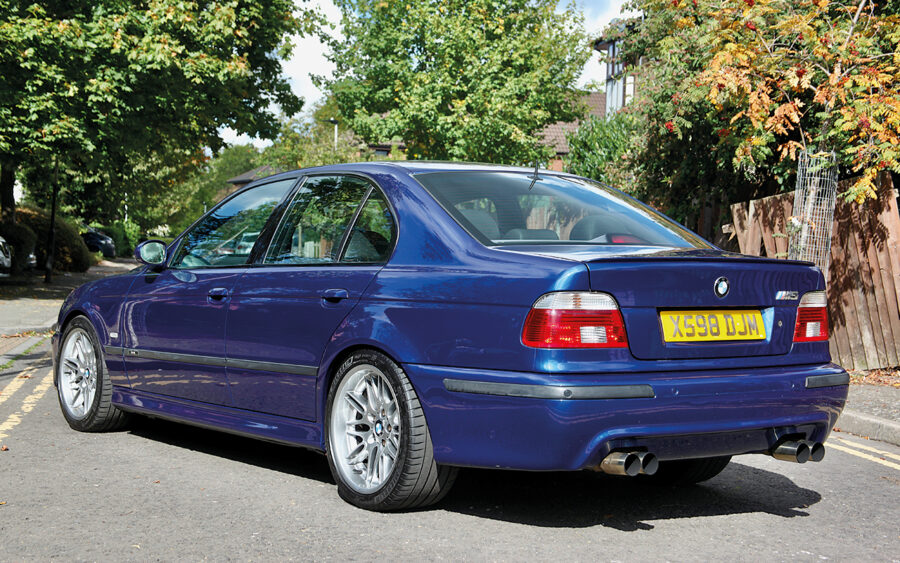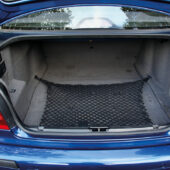The E39 M5 is lauded by many as the ultimate modern-classic sports saloon. We get behind the wheel to see what all the fuss is about
Words and images: Craig Cheetham
There has been an M5 of sorts in the BMW range for almost 40 years, with the E28 derivative making its debut in 1984 – the first of a breed that, four decades later, continues be spoken of in reverential terms by fast saloon enthusiasts.
Of all of the M5s, it’s the E39 that tends to get spoken of with the most affection. It was the first V8-powered M5 and the first to nudge 400bhp – something it did from a normally-aspirated powerplant.
The all-new, all-aluminium V8, branded S62, was BMW’s first engine to use Double VANOS, which adjusted the timing of both intake and exhaust camshafts, and like its six-cylinder predecessors used a throttle body for each cylinder to meter fuel and air with complete precision – at least when working properly. Displacing 4.9-litres, the S62 was set up to deliver 400PS, or 394bhp.
But the main benefit of a switch to a big V8 was torque. Peak power came at 6600rpm, but maximum torque arrived at just 3800rpm. Its 0-60mph time of 5.0 seconds was lively enough, but didn’t tell the full story around its prodigious power delivery or its spread across the rev range.
This car is a 2001 M5 from midway through the E39’s production run, making it an early facelifted car, although the E39 facelift was itself the subtlest of tweaks – after all, if something isn’t broke, why fix it?

Much of it was evolutionary, from its discreet styling to its use of a six-speed manual Getrag transmission and mechanical limited-slip differential. Like the E34 before it, it used MacPherson struts at the front, this time with aluminium control arms, but at the rear was a new multi-link set-up, replacing the traditional BMW trailing arms with a more advanced and tractable set-up. The steering, however, was via a recirculating ball steering box, a necessity on all V8-engined E39s as there wasn’t room to squeeze the six-cylinder car’s rack-and-pinion system into the engine bay around the hefty V8.
This car, finished in stunning Le Mans Blue, was BMW’s own marketing and press demonstrator when new, and apart from a rather rudimentary sat nav system, it’s entirely standard. The interior is a work of art in terms of discreet performance, as well as flawless build quality. The windows are thick and double-glazed, the doors are heavy and close with a satisfying ‘thunk’, and all of the dials and controls have a precision and weight to them that’s simply absent from cars of today – BMW or otherwise. Back in the 1990s, with the formidable Wolfgang Rietzle at the helm of the company, cost-cutting wasn’t how BMW rolled. It’s why the brand’s cars were (quite rightly) thought of as among the very best in the world.
It rocks.
Then there are the M Division touches that make the car that bit more special: the illuminated gear knob, the grey-backed instruments with orange and red light-up segments in the rev counter, which glow until the car is fully warmed through, ready to tell you when it’s safe to open the taps. Then there’s the dual-texture black leather upholstery, which feels like it will never wear through.
Twist the diamond-shaped ignition key and the V8 makes its presence known from the get-go. The M5 rocks as each cylinder fires into life. It then settles to a silken hum as it steadies to an idle, a hum that becomes a rumble and then a growl depending on how hard you provoke the accelerator pedal.
Yet it’s a docile beast if you need it to be. Unlike most modern fast saloons, the M5 doesn’t work from a series of electronic throttle maps, ranging from the frantic-but-usable to the all-or-nothing. Instead, the pedal has a long travel – the amount of horses allowed to pull on the reins determined by how far you push-down the organ-style pedal and nothing more or less than that. Use it lightly and it’s little different to drive than an ordinary E39, other than a fairly heavy clutch. Trample the pedal into the carpet, though, and suddenly the big V8 wakes up – the growl becoming a snarl as it hungrily sucks in air and fuel.

Yet it still remains quite civilised. The gearing is tall, meaning you can cruise quickly and effortlessly all day at motorway speeds, yet if you’re not in the mood to exploit the power to its fullest extent, the broad torque curve allows swift progress from low revs even in fourth or fifth. Again, compare it with the frantic power deliver and ‘intelligent’ two-pedal power delivery of modern super-saloons and it’s arguably more rewarding. The analogue feel of the manual ‘box and lack of forced induction means it does exactly what you want it to do, when you want it to do it – a triumph of analogue over digital that you only tend to notice if you can make a back-to-back comparison.
Where the M5 really comes into its own, though, is on the open road – the fast and twisty routes between cities and motorways that allow you to exploit the car’s wonderfully set-up chassis – a chassis that still manages to deliver a compliant and comfortable ride despite its ability to glue itself limpet-like to the road surface.
You can carve your way across the country with great reward and in utmost confidence that the M5 will do its job, the only minor criticism being a slight lack of immediate steering feel – there are other super saloons that respond instantly to the touch, but the M5 doesn’t. There’s just a moment of hesitation as you turn the wheel – not enough to catch you out, just a little bit of numbness around the straight-ahead position that takes the edge off the M5’s sportiness.
BMW M5 (E39): our verdict
If you are going to buy an E39 M5 then now is the time to do so while you can still get your hands on one for less than £20k. Roughly £17–18k is the going rate for a functioning, relatively tidy M5 with a fair few miles on the clock, but still in generally good working order. Prices scale up from there depending on condition and mileage with the majority of low-ish mileage cars priced between £25–30k, with the truly exceptional ones nudging £40k.
Reliability is generally pretty good as the M5’s big V8 is pretty unstressed most of the time, but there are a few things to watch out for. Mechanically, a repeated rattling or whirring from the top of the engine can mean issues with the VANOS timing units and that’s a big job. Indeed, evidence of a VANOS overhaul is a major selling point for any E39 M5. Listen, too, for a more muted tapping noise, which can be a sign of the timing chain tensioner being worn – not an expensive fix in itself, but it will be if you don’t get it fixed.

Suspension components will wear, too, so listen out for excessive noise from underneath the car and any creaking from the rear, which indicates worn bushes. You also have to accept that the newest E39s are now 20 years old, and what that means is there’s an inevitable need to check the bodywork carefully.
The E39 M5 wears well but age-related corrosion around the rear arches and trailing edge of both sills is common, along with the corners of both front floorpans and the sills around the jacking point areas, all of which require careful checking. Almost all E39s suffer from worn and deteriorated windscreen and door rubbers, too, though you can still get replacements from BMW.
Other than that, the E39 M5 is a wonderful machine. One of the very last truly hands-on, analogue super-saloons – and a benchmark by which all others were judged.
















